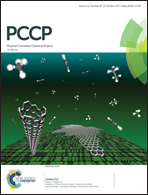Dynamics of excited state proton transfer in nitro substituted 10-hydroxybenzo[h]quinolines†
Abstract
The ground state tautomerism and excited state intramolecular proton transfer (ESIPT) of 10-hydroxybenzo[h]quinoline (HBQ) and its nitro derivatives, 7-nitrobenzo[h]quinolin-10-ol (2) and 7,9-dinitrobenzo[h]quinolin-10-ol (3), have been studied in acetonitrile using steady state as well as time dependent spectroscopy and quantum-chemical calculations. In addition to the enol form absorbance in the range 360–390 nm, the absorption spectra of 2 and 3 exhibit a red shifted band at ∼450 nm. Chemometric data processing, based on individual band decomposition, allowed us to estimate the position of the ground state enol–keto tautomeric equilibrium (ΔG values of 1.03 and 0.62 kcal mol−1 respectively for 2 and 3). The fluorescence stems from the keto form even if the enol form is optically excited as proven by the shape of the excitation spectra indicating that ESIPT takes place. The Stokes shift of the substituted compounds is substantially lower compared to HBQ, which follows from the fact that the substitution occurs in the formal cyclohexa-2,4-dienone moiety and leads to a decrease of the HOMO level of the keto tautomer. The pump–probe experiments show that in the nitro substituted HBQs 2 and 3 ESIPT occurs with a time constant of 0.89 ps and 0.68 ps, respectively. In both cases a mixture of the enol and proton transfer forms is optically excited. The enol form exhibits then the ESIPT and subsequently both fractions take the same relaxation path. We propose that in 2 and 3 the ESIPT path exhibits a potential energy barrier resulting in an incoherent rate governed process while in HBQ the ESIPT proceeds as a ballistic wavepacket motion along a path without significant barriers. The theoretical calculations (M06-2X/TZVP) confirm the existence of a barrier in the ground and excited states as result of the substitution.
![Graphical abstract: Dynamics of excited state proton transfer in nitro substituted 10-hydroxybenzo[h]quinolines](/en/Image/Get?imageInfo.ImageType=GA&imageInfo.ImageIdentifier.ManuscriptID=C7CP04476C&imageInfo.ImageIdentifier.Year=2017)
- This article is part of the themed collection: 2017 PCCP HOT Articles


 Please wait while we load your content...
Please wait while we load your content...